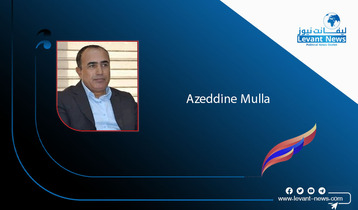-
Operation Peace Spring, U.S. Betrayal or Kurdish Self- deception?

Few minutes to four o'clock, Turkish fighter jets unleashed first bombs on the city of Sere Kaniye and beyond. Loud resounding explosions were heard everywhere. Before the sun could disappear beyond the horizon no body remained in the city except for Kurdish fighters. One of the most horrifying chapters of the Syrian Crisis was unfolding.
On October 9, 2019, world media began transmitting images of artillery and war planes pounding the city of Sere Kaniye (Ras al-Ain)- ancient Rhesaina- in northeast Syria, otherwise known as Rojava.
Turkish armed forces along with allied factions of Syrian National Army (SNA) have commenced "Operation Peace Spring." Within hours, Tal Abyad, to the west, was included in hostilities.
Ostensibly, the operation aimed at dislodging Syrian Kurdish fighters from the border and create a "safe zone" along Turkey's southern border to settle in Syrian refugees living in Turkey instead.
Turkey has always claimed Peoples' Protection Units (YPG) the backbone of the Syrian Democratic Forces (SDF) is the Syrian off-shoot of the outlawed Kurdistan Workers' Party (PKK).
Symbolically, "Peace Spring" corresponds to the day- in 1998- on which Abdullah Ocalan, PKK's leader, who- following the "October Crisis" between Damascus and Ankara- was forced to leave Syrian soil to be captured in Kenya months later.
To the astonishment of the Kurds, the offensive was green lighted- or assumed so- by the then U.S. President Donald Trump.
Being the main partner to the U.S.- led Global Coalition to Defeat ISIS, the Kurds proved loyal and effective in the fight against the Islamic State (Isis).
However, the abrupt withdrawal of the U.S. troops from Rojava left the Kurds face to face with the highly advanced Turkish war machinery. The operation evoked abandonment by Russian forces of YPG in Afrin a year prior.
The Kurds maintain they fought Isis on behalf of the whole world. That was a favour that should have been reciprocated in a better way; rather. Rojava's officials and public alike said Turkey's operation was a U.S. stab in the their backs.
However, by looking into the run- up to the operation, one could understand the operation was planned in advance and carried out meticulously.
Erdogan's safe zone has its foundations laid down in an agreement with the United States dated 7 August 2019 following two- day intense discussions to establish a joint operation center.
On that day, Turkey and the United States reached a mechanism to establish a Joint Operation Centre (JOC) in the Turkish city of Urfa to coordinate efforts and manage a planned safe zone in northeast Syria, a move that appeared to reduce chances of imminent Turkish cross- border military action.
Based on a proposal, the United States said it aimed to ease tension between the Nato ally and its Kurdish partners.
The U.S. proposal of a "safe zone" then included a joint U.S.- Turkish military operation to secure a strip of south of Syria – Turkey border that would be about nine miles deep and 87 miles long and from which the Kurdish fighters would be withdrawn.
The proposal was that the U.S. and Turkish militaries would destroy and disable Kurdish fortifications and then jointly patrol the area, located in the middle third of the northeastern border stretching between the Euphrates River and Iraq. The other two- thirds would be cleared later. That did not meet Turkish aspirations.
Beneath Turkish border- in Rojava- precursors of a Turkish imminent operation was increasing day by day since two month prior.
By late August, the Kurdish forces had demolished all their fortifications and emplacements. On August 24, fortifications in Sere Kaniye were demolished, two days later that was done in Tal Abyad. Eventually and actually, the SDF had no real presence in the military terms of the word.
"We are implementing the agreement and we have no problem with it as long as it prevents war," SDF's affiliated Tal Abyad Military Council stated then.
The Kurds thought- mistakenly rather- that the matter was wholly settled. However, that was half of the truth the most important and horrifying part of which was still to be unfolded.
On September 8, the very first ever U.S.- Turkish joint- air and then field- patrol(s) were mounted in the area of the would- be operation. The Turkish defence ministry said drones were also deployed.
Militarily, the deployment by Turkish air forces of drone technology was strategic and to the point.
On October 5, Turkish President said Turkish armed forces were to launch soon a military incursion into east of Euphrates in Syria. Erdogan further went on to say "an air and ground military operation would be launched in the next two days in a region east of the Euphrates."
While the Turkish President confirmed all preparations were made, plans of the operations were finalized and necessary instructions were given, the U.S. remained inactive and indifferent.
On October 7, U.S. troops evacuated their base located at the village of Tal al-Arqam, some 10 kilometers in west Sere Kaniye city paving the way for the Turkish assault.
By the time the operation was launched, Kurdish forces had no longer any significant presence except for limited offices inside the two cities of Sere Kaniye and Tal Abyad. Unknowingly, the Kurds were disarmed.
It was a naïve idea the Kurds embraced for a while. The area had been demilitarized. Cunningly, they Kurds were thrown into the lion's den.
With no heavy presence in the vast rural area between Sere Kaniye and Tal Abyad added to the tribal betrayals of SDF's affiliated fighters and the action of aerial bombardment against a mostly flat territory, Turkey's third Rojava invasion reached its goals within a very short period of time.
The murder of Havrine Khalaf, head of Syria's Future Party, on the M4 on October 11 by extremist opposition fighters remains unanswered mystery.
On October 18, hostilities were brought to a halt by U.S. Vice President Mike Pence. A 120 hours ceasefire term was given to the Kurdish fighters to withdraw from the border area under U.S. supervision.
Though coming short of Erdogan's expectations, the ceasefire was practically a clear embrace by the U.S. of Turkey's position in the 9- day battle against the Kurdish forces.
Most importantly, before Erdogan- Pence agreement expire, Erdogan reached a more important 150- hours ceasefire agreement with his Russian counterpart Vladimir Putin.
The agreement which was signed in the Russian city of Sochi on October 22, was important in the sense it laid down the foundation stone of the Russian policy in east Euphrates marking practically the end of U.S. influence in the Kurdish north.
The agreement lead to the Syrian regime and Russian forces extending their control to territory from which American troops have withdrawn, underlining how the Turkey's operation has shifted the dynamics on the ground in northeast Syria.
Erdogan, to the satisfaction of Russians, described Sochi's agreement as an "historic understanding."
However, when weapons fell silent, Turkey had occupied a 120km- long, and 30km- deep strip of territory between Sere Kaniye and Tal Abyad and instead Syrian forces were deployed to areas formerly under SDF along border with Turkey.
"Operation Peace Spring" covers the middle third of the Erdogan- Trump "safe zone" with the two other thirds scheduled to be cleared later.

BY: Lazghine Ya'qoube
You May Also Like
Popular Posts
Caricature
BENEFIT Sponsors BuildHer...
- April 23, 2025
BENEFIT, the Kingdom’s innovator and leading company in Fintech and electronic financial transactions service, has sponsored the BuildHer CityHack 2025 Hackathon, a two-day event spearheaded by the College of Engineering and Technology at the Royal University for Women (RUW).
Aimed at secondary school students, the event brought together a distinguished group of academic professionals and technology experts to mentor and inspire young participants.
More than 100 high school students from across the Kingdom of Bahrain took part in the hackathon, which featured an intensive programme of training workshops and hands-on sessions. These activities were tailored to enhance participants’ critical thinking, collaborative problem-solving, and team-building capabilities, while also encouraging the development of practical and sustainable solutions to contemporary challenges using modern technological tools.
BENEFIT’s Chief Executive Mr. Abdulwahed AlJanahi, commented: “Our support for this educational hackathon reflects our long-term strategic vision to nurture the talents of emerging national youth and empower the next generation of accomplished female leaders in technology. By fostering creativity and innovation, we aim to contribute meaningfully to Bahrain’s comprehensive development goals and align with the aspirations outlined in the Kingdom’s Vision 2030—an ambition in which BENEFIT plays a central role.”
Professor Riyadh Yousif Hamzah, President of the Royal University for Women, commented: “This initiative reflects our commitment to advancing women in STEM fields. We're cultivating a generation of creative, solution-driven female leaders who will drive national development. Our partnership with BENEFIT exemplifies the powerful synergy between academia and private sector in supporting educational innovation.”
Hanan Abdulla Hasan, Senior Manager, PR & Communication at BENEFIT, said: “We are honoured to collaborate with RUW in supporting this remarkable technology-focused event. It highlights our commitment to social responsibility, and our ongoing efforts to enhance the digital and innovation capabilities of young Bahraini women and foster their ability to harness technological tools in the service of a smarter, more sustainable future.”
For his part, Dr. Humam ElAgha, Acting Dean of the College of Engineering and Technology at the University, said: “BuildHer CityHack 2025 embodies our hands-on approach to education. By tackling real-world problems through creative thinking and sustainable solutions, we're preparing women to thrive in the knowledge economy – a cornerstone of the University's vision.”
opinion
Report
ads
Newsletter
Subscribe to our mailing list to get the new updates!






















